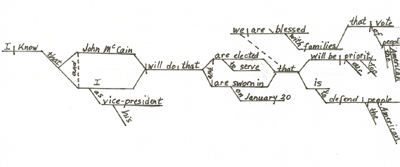Can Palin's sentences stand up to a grammarian?
There are plenty of people out there—not only English teachers but also amateur language buffs like me—who believe that diagramming a sentence provides insight into the mind of its perpetrator. The more the diagram is forced to wander around the page, loop back on itself, and generally stretch its capabilities, the more it reveals that the mind that created the sentence is either a richly educated one—with a Proustian grasp of language that pushes the limits of expression—or such an impoverished one that it can produce only hot air, baloney, and twaddle.
I found myself considering this paradox once again when confronted with the sentences of Sarah Palin, the Republican vice-presidential nominee. No one but a Republican denial specialist could argue with the fact that Sarah Palin's recent TV appearances have scaled the heights of inanity. The sentences she uttered in interviews with Charles Gibson, Sean Hannity, and Katie Couric seem to twitter all over the place like mourning doves frightened at the feeder. Which left me wondering: What can we learn from diagramming them?
One thing we can't learn, of course, is whether her words are true or make sense. Part of the appeal of diagramming is the fact that just about any sentence can be diagrammed, even when it is gibberish. Cats chase mice and Mice chase cats present the same kind of entity to the diagrammer. So does Muffins bludgeon bookcases. If it's a string of words containing a certain number of parts of speech arranged in reasonably coherent order, it can be hacked and beaten into a diagram.
Once we start diagramming political sentences, the diagram's indifference to meaning can be especially striking. Stirring words like "I have a dream," the magisterial Declaration of Independence (a staple of diagramming teachers), bald-faced lies ("I am not a crook"), and crafty shadings of the truth ("I did not have sexual relations with that woman") can be diagrammed with equal ease. But some politicians—our current president included—offer meanderings in the higher realms of drivel that leave the diagrammer groping for the Tylenol ("Families is where our nation finds hope, where wings take dream") or the gin bottle ("I remember meeting a mother of a child who was abducted by the North Koreans right here in the Oval Office").
So let's take a crack at a few of Palin's doozies. From the Katie Couric interview:
It's very important when you consider even national security issues with Russia as Putin rears his head and comes into the air space of the United States of America, where—where do they go?
A diagrammer doesn't care about who "they" are in that last stuttered question or fuss over the problem of the head-rearing Putin coming into our "air space." A diagrammer simply diagrams. I didn't have a clue about what to do with the question that ends it. Otherwise, in its mice chase cats way, the sentence is perfectly diagrammable.
Other Palinisms are not so tractable. From the Charlie Gibson interview:
I know that John McCain will do that and I, as his vice president, families we are blessed with that vote of the American people and are elected to serve and are sworn in on January 20, that will be our top priority is to defend the American people.
I didn't stop to marvel at the mad thrusting of that pet political watchword "families" into the text. I just rolled up my sleeves and attempted to bring order out of the chaos:
I had to give up. This sentence is not for diagramming lightweights. If there's anyone out there who can kick this sucker into line, I'd be delighted to hear from you.










No comments:
Post a Comment